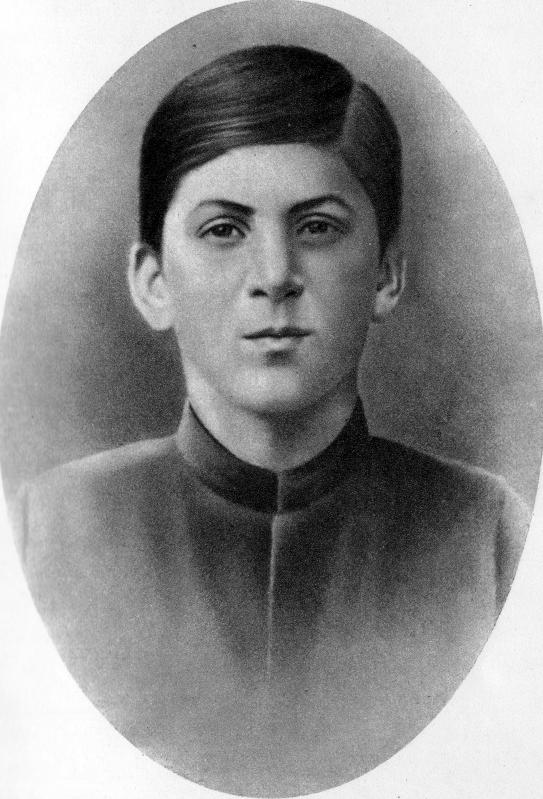On 18 December 1878, in the town of Gori, Georgia, was born one history’s greatest tyrants, Joseph Vissarionovich Dzhugashvili, better known to history by his adopted name – Stalin, ‘man of steel’. For reasons that remain a mystery, Joseph Stalin always maintained he was born on 21 December 1879 and it was this date that was celebrated throughout his life. The change of date may possibly be to do with Stalin’s attempts to confuse and evade the tsar’s secret police.
 Joseph Stalin’s father, Vissarion Dzhugashvili, known as Basu, was a shoemaker. An alcoholic, he spent much of his time in Tiflis (now Tbilisi, the Georgian capital, 50 miles east of Gori) producing shoes for the Russian army. On his drunken and increasingly rare appearances at home, he would beat his wife and son. (Pictured is Stalin, aged 15, in 1894).
Joseph Stalin’s father, Vissarion Dzhugashvili, known as Basu, was a shoemaker. An alcoholic, he spent much of his time in Tiflis (now Tbilisi, the Georgian capital, 50 miles east of Gori) producing shoes for the Russian army. On his drunken and increasingly rare appearances at home, he would beat his wife and son. (Pictured is Stalin, aged 15, in 1894).
‘Like a Tsar’
Stalin’s mother, Ekaterina, or ‘Keke’, also meted out punishment on her son but generally was protective of her ‘Soso’ (Georgian for ‘Little Joey’), especially on account that her first two children, both boys, had died in infancy. Stalin only learnt to speak Russian when aged about nine but never lost his strong Georgian accent.
In later life, Stalin arranged for his mother to move into a large mansion in Tiflis but a woman of humble needs, she felt uncomfortable with such luxury and confined herself to one small room. She turned down her son’s requests to visit him in Moscow and Stalin, never fond of travelling, visited her only rarely. She once asked her son, ‘Joseph, what exactly are you now? He replied, ‘Do you remember the tsar? Well, I’m like a tsar.’ ‘You’d have done better to have been a priest,’ she said in response.
Joseph Stalin suffered many complexes about himself. As a child he endured a bout of smallpox which left his face permanently pockmarked; a childhood accident caused his left arm to be four inches shorter than the right; his second and third toes of his left foot were joined; he had bad teeth from his many years in exile (‘black, irregular and turned inward’ by one description); and, most damning for such a towering figure, he was only five feet, three inches tall. Specially-made shoes gave him an extra inch or two but his height, or lack of it, remained a constant source of irritation.
Stalin was brought up in an atmosphere of violence. The town of Gori was a rough town, in which its male inhabitants enjoyed organized street brawling, lasting for hours at a time. On 13 February 1892, Stalin, alongside his schoolmates, witnessed the public hanging of two criminals. The executions were botched and Stalin, traumatised, came away with a new-found hatred of the tsarist regime.
Education
Stalin’s mother, determined that he should have a respectable position in life and to repay God’s benevolence for his survival, sent him to a church school. Young Soso did well. He sang in the church choir and impressed his teachers with his intelligence and, in memorising large tracts of the bible, his excellent memory. Earning top marks, he graduated two years ahead of schedule in 1894.
At the age of fifteen, Stalin was awarded a scholarship to the theology seminary in Tiflis. But the teenage Stalin was more taken with the writings of Marx and Engels than the bible and, declaring himself a Marxist and an atheist, joined the Russian Social Democratic Labour Party (RSDLP), forerunner to the Bolshevik and Menshevik parties, extolling his fellow students to do likewise.
 In 1899, Stalin was expelled from the seminary, supposedly for his Marxist leanings. Having adopted the revolutionary name of Koba, the name of a Georgian Robin Hood-styled folk hero, Stalin embarked on the revolutionary path, organising strikes and creating disturbances in various Georgian towns.
In 1899, Stalin was expelled from the seminary, supposedly for his Marxist leanings. Having adopted the revolutionary name of Koba, the name of a Georgian Robin Hood-styled folk hero, Stalin embarked on the revolutionary path, organising strikes and creating disturbances in various Georgian towns.
In his attempts to avoid the Okhrana, Tsar Nicholas II’s secret police, Stalin adopted several different aliases and was constantly on the move. Yet, between 1902 and 1913, he was arrested six times, each time managing to escape and return west, often travelling on forged documents. The comparative ease of escape, merely hopping onto a westbound train, led to speculation that Stalin was in the employ of the Okhrana as a double agent. He was arrested for the final time in February 1913 and spent four years in various parts of Siberia.
The ‘Wonderful Georgian’
Stalin first met Vladimir Lenin, the Bolshevik leader, on 7 January 1906 at a party conference in Tampere, Finland.
Lenin was impressed with Stalin, calling him the ‘wonderful Georgian’. In 1912, with Lenin’s prompting, Stalin, who was serving a jail sentence, was appointed, in absentia, to the Bolshevik Central Committee. It was about this time that Stalin dropped his Georgian alias, Koba. His birth name, Dzhugashvili, was too much a Georgian giveaway and, for his Russian colleagues, too difficult to pronounce. In a letter to a Bolshevik colleague, Lenin once wrote,‘Do me a big favour – find out from someone “Koba’s” last name… (Joseph Dzh…? We’ve forgotten. Very important!)’
(Although later, Lenin criticised Stalin in his ‘Testament‘, written in December 1922).
Koba was gone; replaced by ‘Man of Steel’. Stalin had arrived.
 Rupert Colley.
Rupert Colley.
Read more Soviet / Russian history in The Clever Teens’ Guide to the Russian Revolution (80 pages) available as paperback and ebook from Amazon, Barnes & Noble, Waterstone’s, Apple Books and other stores.